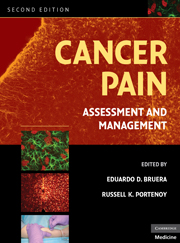Book contents
- Frontmatter
- Contents
- Contributors
- Preface
- SECTION I MECHANISMS AND EPIDEMIOLOGY
- 1 Nociception: basic principles
- 2 Pathophysiology of malignant bone pain
- SECTION II EPIDEMIOLOGY AND SYNDROMES
- SECTION III ASSESSMENT
- SECTION IV PHARMACOLOGICAL TREATMENT
- SECTION V OTHER INTERVENTIONAL STRATEGIES
- SECTION VI REHABILITATION AND PSYCHOLOGICAL INTERVENTIONS
- SECTION VII THE ROLE OF ANTINEOPLASTIC THERAPIES IN PAIN CONTROL
- SECTION VIII PAIN IN SPECIAL POPULATIONS
- SECTION IX DIFFICULT PAIN PROBLEMS
- SECTION X SYSTEMS OF CARE
- Index
- Plate section
- References
1 - Nociception: basic principles
from SECTION I - MECHANISMS AND EPIDEMIOLOGY
Published online by Cambridge University Press: 06 July 2010
- Frontmatter
- Contents
- Contributors
- Preface
- SECTION I MECHANISMS AND EPIDEMIOLOGY
- 1 Nociception: basic principles
- 2 Pathophysiology of malignant bone pain
- SECTION II EPIDEMIOLOGY AND SYNDROMES
- SECTION III ASSESSMENT
- SECTION IV PHARMACOLOGICAL TREATMENT
- SECTION V OTHER INTERVENTIONAL STRATEGIES
- SECTION VI REHABILITATION AND PSYCHOLOGICAL INTERVENTIONS
- SECTION VII THE ROLE OF ANTINEOPLASTIC THERAPIES IN PAIN CONTROL
- SECTION VIII PAIN IN SPECIAL POPULATIONS
- SECTION IX DIFFICULT PAIN PROBLEMS
- SECTION X SYSTEMS OF CARE
- Index
- Plate section
- References
Summary
Introduction
Pain has been a major concern in the clinic for many decades. In recent years, considerable progress has been made with respect to our understanding of both acute and chronic pain mechanisms. This has largely been attributed to advancements in molecular biology and genomic techniques, as well as the use of animal models, which has allowed us to explore mechanisms and networks of neurons involved in pain processes. This has fundamentally altered our understanding of the pathophysiology of pain mechanisms and has led to the hope of development of novel analgesics.
The study of the receptor systems involved in the transmission of pain and its modulation involves investigation of processes occurring at the peripheral endings of sensory neurons, as well as central events. The mechanisms of inflammatory, visceral and neuropathic pain are different from those of acute pain, and cancer pain may both overlap and differ in some respects with these broad categories. Furthermore, there is considerable plasticity in both the transmission and modulating systems in these prolonged pain states so that systems change over time. The search for new treatments for these pain states requires the development of valid animal models. For such models to be valid, a number of criteria must be fulfilled. First, the model must provide reproducible and quantifiable behavioral data. Second, the model must produce behaviors in the animal that resemble some of the pain syndromes observed in humans (e.g., allodynia, hyperalgesia).
- Type
- Chapter
- Information
- Cancer PainAssessment and Management, pp. 3 - 22Publisher: Cambridge University PressPrint publication year: 2009

